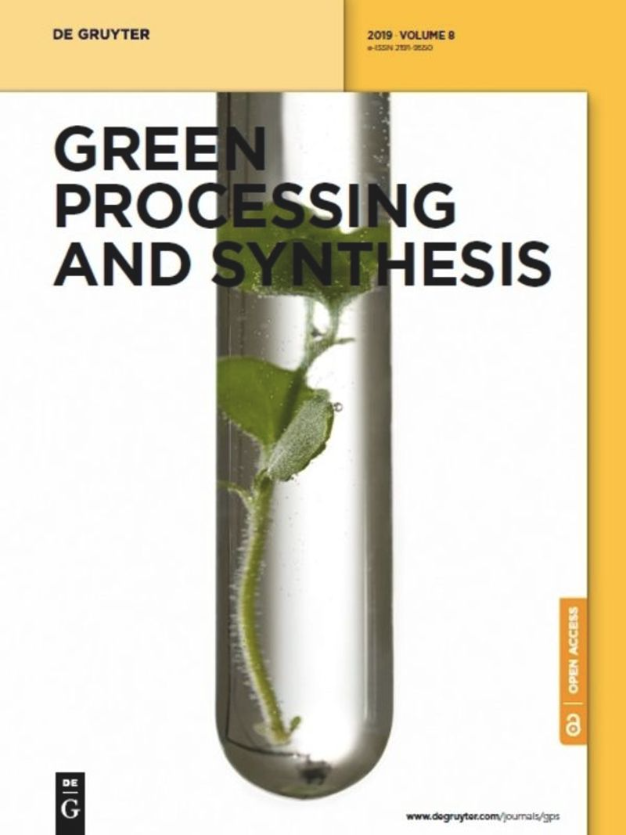Synthesis and characterization of silver nanoparticles using Origanum onites leaves: Cytotoxic, apoptotic, and necrotic effects on Capan-1, L929, and Caco-2 cell lines
IF 3
4区 工程技术
Q2 CHEMISTRY, MULTIDISCIPLINARY
引用次数: 5
Abstract
Abstract In this study, Origanum onites was used to synthesize the silver nanoparticles (AgNPs@Org). The structure of nanoparticles was identified by spectroscopic techniques. The maximum absorption was determined as 433 nm by UV-Vis spectroscopy. In Fourier-transform infrared spectroscopy spectrum, the characteristic signal was observed at 3,262 cm−1 belonging to the OH group. The crystal structure of nanoparticles was revealed by X-ray diffraction analysis. The diffraction peaks (2θ) can be indexed to 111, 200, 220, 311, and 222 components representing the face-centered cubic unit structure. The spherical particle size was calculated as 18.1 nm by transmission electron microscopy. Cytotoxic effects of extract and AgNPs@Org were executed by MTT assay using Capan-1, L929, and Caco-2 cell lines. AgNPs@Org exhibited the excellent cytotoxic effect on Capan-1 cell lines with the viability of 37.6% (0.5 µg·mL−1). However, the effect of O. onites extract on the viability of Capan-1 cell lines was found to be 24.6% and 55.4% at 1.0 and 0.5 µg·mL−1, respectively. AgNPs@Org effect on Caco-2 cell lines was found as 31.7% (1.0 µg·mL−1). In the L929 cell lines, the noticeable lethal influence was not detected for extract and nanoparticles. In other words, the extract and AgNPs@Org did not act a cytotoxic effect on L929 cell lines. Graphical abstract Synthesis, characterization, and anticancer activity of silver nanoparticles synthesized from Origanum onites.利用牛至叶合成和表征银纳米颗粒:对Capan-1、L929和Caco-2细胞系的细胞毒性、凋亡和坏死作用
摘要本研究以牛至为原料合成了纳米银(AgNPs@Org)。通过光谱技术鉴定了纳米颗粒的结构。最大吸收量确定为433 nm。在傅立叶变换红外光谱中,在3262处观察到特征信号 cm−1属于OH基团。通过X射线衍射分析揭示了纳米颗粒的晶体结构。衍射峰(2θ)可以被索引为代表面心立方单位结构的111、200、220、311和222分量。球形颗粒尺寸计算为18.1 nm。提取物和AgNPs@Org使用Capan-1、L929和Caco-2细胞系通过MTT测定进行。AgNPs@Org对Capan-1细胞系表现出优异的细胞毒性作用,存活率为37.6%(0.5 µg·mL−1)。然而,在1.0和0.5时,奥氏菌提取物对Capan-1细胞系活力的影响分别为24.6%和55.4% µg·mL−1。AgNPs@Org对Caco-2细胞系的影响为31.7%(1.0 µg·mL−1)。在L929细胞系中,提取物和纳米颗粒没有检测到明显的致死影响。换句话说,摘录和AgNPs@Org对L929细胞系没有细胞毒性作用。由牛粪石合成的银纳米颗粒的合成、表征和抗癌活性。
本文章由计算机程序翻译,如有差异,请以英文原文为准。
求助全文
约1分钟内获得全文
求助全文
来源期刊

Green Processing and Synthesis
CHEMISTRY, MULTIDISCIPLINARY-ENGINEERING, CHEMICAL
CiteScore
6.70
自引率
9.30%
发文量
78
审稿时长
7 weeks
期刊介绍:
Green Processing and Synthesis is a bimonthly, peer-reviewed journal that provides up-to-date research both on fundamental as well as applied aspects of innovative green process development and chemical synthesis, giving an appropriate share to industrial views. The contributions are cutting edge, high-impact, authoritative, and provide both pros and cons of potential technologies. Green Processing and Synthesis provides a platform for scientists and engineers, especially chemists and chemical engineers, but is also open for interdisciplinary research from other areas such as physics, materials science, or catalysis.
 求助内容:
求助内容: 应助结果提醒方式:
应助结果提醒方式:


